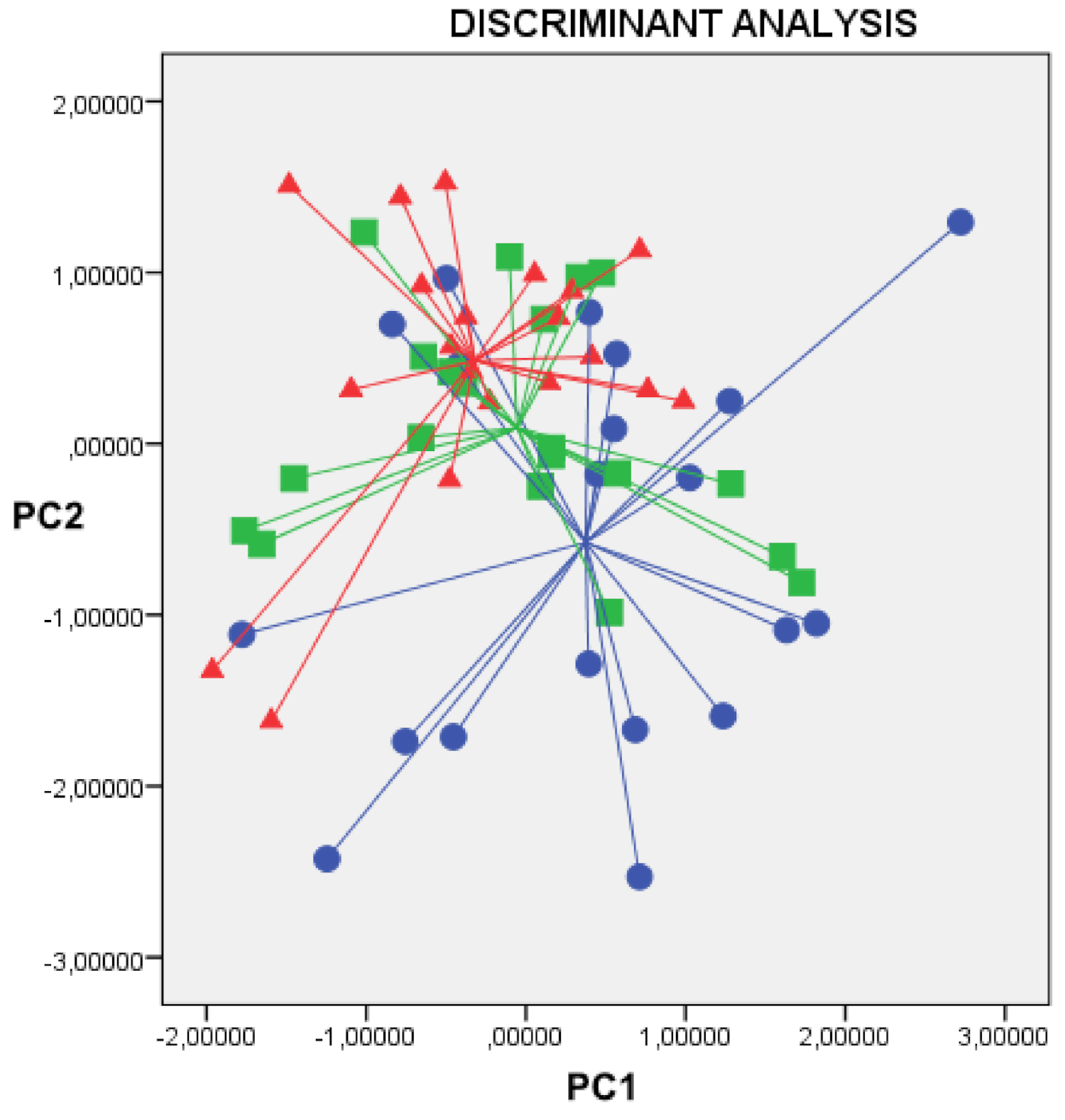Breathing Rhythm Variations during Wash-In Do Not Influence Exhaled Volatile Organic Compound Profile Analyzed by an Electronic Nose
Abstract
:1. Introduction
2. Results
3. Discussion
4. Materials and Methods
4.1. Patients
4.2. Study Design
4.3. Electronic Nose
4.4. Statistical Analysis
Author Contributions
Funding
Institutional Review Board Statement
Informed Consent Statement
Data Availability Statement
Conflicts of Interest
References
- Haick, H.; Broza, Y.Y.; Mochalski, P.; Ruzsanyi, V.; Amann, A. Assessment, origin, and implementation of breath volatile cancer markers. Chem. Soc. Rev. 2014, 43, 1423–1449. [Google Scholar] [CrossRef] [PubMed] [Green Version]
- Wilson, A.D.; Baietto, M. Advances in Electronic-Nose Technologies Developed for Biomedical Applications. Sensors 2011, 11, 1105–1176. [Google Scholar] [CrossRef] [PubMed]
- Dragonieri, S.; Pennazza, G.; Carratu, P.; Resta, O. Electronic Nose Technology in Respiratory Diseases. Lung 2017, 195, 157–165. [Google Scholar] [CrossRef] [PubMed]
- Horváth, I.; Barnes, P.J.; Loukides, S.; Sterk, P.J.; Högman, M.; Olin, A.-C.; Amann, A.; Antus, B.; Baraldi, E.; Bikov, A.; et al. A European Respiratory Society technical standard: Exhaled biomarkers in lung disease. Eur. Respir. J. 2017, 49, 1600965. [Google Scholar] [CrossRef] [PubMed] [Green Version]
- Kindig, N.B.; Hazlett, D.R. The effects of breathing pattern in the estimation of pulmonary diffusing capacity. Q. J. Exp. Physiol. Cogn. Med. Sci. 1974, 59, 311–329. [Google Scholar] [CrossRef] [PubMed]
- Duffin, J. The fast exercise drive to breathe. J. Physiol. 2013, 592, 445–451. [Google Scholar] [CrossRef] [PubMed]
- Dragonieri, S.; Schot, R.; Mertens, B.J.; Le Cessie, S.; Gauw, S.A.; Spanevello, A.; Resta, O.; Willard, N.P.; Vink, T.J.; Rabe, K.F.; et al. An electronic nose in the discrimination of patients with asthma and controls. J. Allergy Clin. Immunol. 2007, 120, 856–862. [Google Scholar] [CrossRef] [PubMed] [Green Version]
- Modarreszadeh, M.; Bruce, E.N. Ventilatory variability induced by spontaneous variations of PaCO2 in humans. J. Appl. Physiol. 1994, 1985, 2765–2775. [Google Scholar] [CrossRef] [PubMed]
- Dornhorst, A.C.; Howard, P.; Leathart, G.L. Respiratory Variations in Blood Pressure. Circulation 1952, 6, 553–558. [Google Scholar] [CrossRef] [PubMed] [Green Version]
- Boshier, P.R.; Priest, O.H.; Hanna, G.B.; Marczin, N. Influence of respiratory variables on the on-line detection of exhaled trace gases by PTR-MS. Thorax 2011, 66, 919–920. [Google Scholar] [CrossRef] [PubMed] [Green Version]
- Bikov, A.; Paschalaki, K.; Logan-Sinclair, R.; Horváth, I.; Kharitonov, S.A.; Barnes, P.J.; Usmani, O.S.; Paredi, P. Standardised exhaled breath collection for the measurement of exhaled volatile organic compounds by proton transfer reaction mass spectrome-try. BMC Pulm. Med. 2013, 13, 43. [Google Scholar] [CrossRef] [PubMed] [Green Version]
- Lärstad, M.A.E.; Torén, K.; Bake, B.; Olin, A.-C. Determination of ethane, pentane and isoprene in exhaled air-effects of breath-holding, flow rate and purified air. Acta Physiol. 2007, 189, 87–98. [Google Scholar] [CrossRef]
- Bikov, A.; Hernadi, M.; Korosi, B.Z.; Kunos, L.; Zsamboki, G.; Sutto, Z.; Tarnoki, A.D.; Tarnoki, D.L.; Losonczy, G.; Horvath, I. Expiratory flow rate, breath hold and anatomic dead space influence electronic nose ability to detect lung cancer. BMC Pulm. Med. 2014, 14, 1–9. [Google Scholar] [CrossRef] [PubMed] [Green Version]
- Sukul, P.; Schubert, J.K.; Zanaty, K.; Trefz, P.; Sinha, A.; Kamysek, S.; Miekisch, W. Exhaled breath compositions under varying respiratory rhythms reflects ventilatory variations: Translating breathomics towards respiratory medicine. Sci. Rep. 2020, 10, 1–16. [Google Scholar] [CrossRef] [PubMed]
- Ibrahim, W.; Carr, L.; Cordell, R.; Wilde, M.J.; Salman, D.; Monks, P.S.; Thomas, P.; Brightling, C.E.; Siddiqui, S.; Greening, N.J. Breathomics for the clinician: The use of volatile organic compounds in respiratory diseases. Thorax 2021, 76, 514–521. [Google Scholar] [CrossRef] [PubMed]
- Dragonieri, S.; Quaranta, V.N.; Carratu, P.; Ranieri, T.; Resta, O. Influence of age and gender on the profile of exhaled volatile organic compounds analyzed by an electronic nose. J. Bras. Pneumol. 2016, 42, 143–145. [Google Scholar] [CrossRef] [PubMed] [Green Version]

| Parameter | Value |
|---|---|
| Subjects (n.) | 20 |
| M\F (n.) | 11\9 |
| Age (y.) | 37.1 ± 10.2 |
| FEV1%pred. | 103.6 ± 10.7 |
| BMI | 25.52 ± 2.4 |
| (ex)-smokers (n.) | 0 |
| comorbidities(n.) | 0 |
| Normal Rhythm | Fast Rhythm | Slow Rhythm | p | |
|---|---|---|---|---|
| PC1 | −0.131 ± 1.045 | 0.050 ± 0.955 | 0.081 ± 1.035 | 0.773 |
| PC2 | 0.374 ± 1.113 | −0.054 ± 0.983 | −0.320 ± 0.801 | 0.084 |
| PC3 | 0.577 ± 1.178 | 0.091 ± 0.667 | 0.485 ± 0.814 | 0.182 |
| PC4 | −0.003 ± 1.162 | 0.008 ± 1.031 | −0.005 ± 0.831 | 0.999 |
Publisher’s Note: MDPI stays neutral with regard to jurisdictional claims in published maps and institutional affiliations. |
© 2021 by the authors. Licensee MDPI, Basel, Switzerland. This article is an open access article distributed under the terms and conditions of the Creative Commons Attribution (CC BY) license (https://creativecommons.org/licenses/by/4.0/).
Share and Cite
Dragonieri, S.; Quaranta, V.N.; Carratù, P.; Ranieri, T.; Buonamico, E.; Carpagnano, G.E. Breathing Rhythm Variations during Wash-In Do Not Influence Exhaled Volatile Organic Compound Profile Analyzed by an Electronic Nose. Molecules 2021, 26, 2695. https://doi.org/10.3390/molecules26092695
Dragonieri S, Quaranta VN, Carratù P, Ranieri T, Buonamico E, Carpagnano GE. Breathing Rhythm Variations during Wash-In Do Not Influence Exhaled Volatile Organic Compound Profile Analyzed by an Electronic Nose. Molecules. 2021; 26(9):2695. https://doi.org/10.3390/molecules26092695
Chicago/Turabian StyleDragonieri, Silvano, Vitaliano Nicola Quaranta, Pierluigi Carratù, Teresa Ranieri, Enrico Buonamico, and Giovanna Elisiana Carpagnano. 2021. "Breathing Rhythm Variations during Wash-In Do Not Influence Exhaled Volatile Organic Compound Profile Analyzed by an Electronic Nose" Molecules 26, no. 9: 2695. https://doi.org/10.3390/molecules26092695
APA StyleDragonieri, S., Quaranta, V. N., Carratù, P., Ranieri, T., Buonamico, E., & Carpagnano, G. E. (2021). Breathing Rhythm Variations during Wash-In Do Not Influence Exhaled Volatile Organic Compound Profile Analyzed by an Electronic Nose. Molecules, 26(9), 2695. https://doi.org/10.3390/molecules26092695








